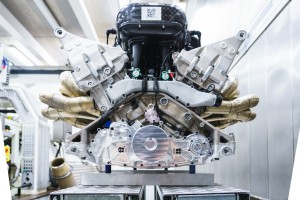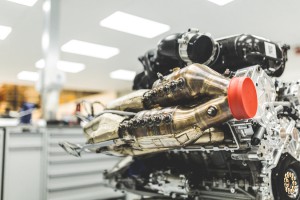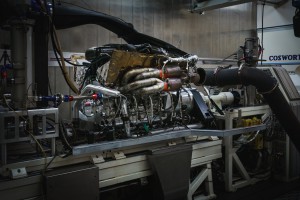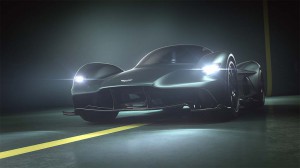
This snarling V-12 puts out 1,000 horsepower and 11,000 rpms and it powers the new Aston Martin Valkyrie.
The horsepower race continues to accelerate. Where 400 hp was once considered extreme, more and more exotics are nudging into four-figure territory, Aston Martin the latest to get there by taking some of its Formula One technology from the track to the street.
The British marque’s new Valkyrie is still more than a year away from production but it is offering up a first look at what will become the hypercar’s beating heart, a hybridized V-12 capable of revving up to a dizzying 11,000 rpms in the process of punching out a full 1,000 horsepower.
“To anyone with a drop of petrol in their blood, a high-revving naturally aspirated V12 is the absolute pinnacle. Nothing sounds better or encapsulates the emotion and excitement of the internal combustion engine more completely,” proclaimed Aston CEO Andy Palmer in a release accompanying these images.
The Valkyrie is just one of an assortment of new models Aston is now rolling out under the “Second Century Plan” Palmer announced shortly after coming onboard as chief executive in September 2014. That includes comparatively mainstream models like the DB11, the first among seven core product lines, as well as the more exotic DBS Superleggera introduced earlier this year.
(Aston Martin confirms DBX name, shows new SUV testing. Click Here for the story.)

Inspired by its Formula 1 powerplant, the new V-12 will be the engine for the limited edition Valkyrie.
But the Aston Martin Valkyrie takes things to the extreme, with only 150 copies to be produced.
It won’t be the most powerful hypercar on the road. The Bugatti Chiron, for one example, makes 1,479 hp, but with its superlight body and advanced aerodynamics, the Valkyrie will be no slouch once a driver puts pedal to the metal.
What’s particularly impressive, as Palmer points out, is the lack of any turbo or supercharging – though the Aston two-seater will get a solid boost from a new hybrid drive system.
The project is a joint venture of Aston and its Formula One partner Red Bull Racing, with the engine being developed by Britain’s Cosworth Engineering. The naturally aspirated, 65-degree V-12 can rev up to 11,000 RPMs, pressing into F1 territory. It actually hits peak horsepower at 10,500 RPMs, while torque comes on much more quickly, peaking out at 545 pound-feet at 7,000 revs.

Unlike many of its four-figure horsepower counterparts, the Valkyrie's new V-12 uses no turbos or superchargers to get that monstrous power.
That’s actually a bit misleading. Aston isn’t ready to offer much in the way of details on the electric side of the package, so we’re not sure how close it is to the Kinetic Energy Recovery System, or KERS, now used in F1, but we can assume it will deliver much of that torque the moment the engine starts revving up, electric motors generating max torque the moment they begin to spin. That’s one plus over the conventional turbos found on many other hypercars.
(Click Here for details about Aston Martin rolling out a limited line of “Goldfinger” DB5s.)
As you can expect of an engine expected to spin at such speeds, Aston has had to do a lot more than just beef up one of the V-12s found in its more conventional street-legal line-up.
“We knew this would be a challenge like no other,” said Bruce Wood, Cosworth’s managing director.
There were conflicting targets and requirements that track cars don’t face, though the Valkyrie V-12 did share some, including an emphasis on lightweighting. Aston expects the production powertrain to weigh in at just 206 kilograms, or 453 pounds.

Aston's new Valkyrie is the latest in a series of exotic "V' cars dating back to 1951. The company plans to build just 150.
That’s actually lighter, on a specific displacement basis, than the old Cosworth 3.0-liter V-10 used in Formula One. It tipped the scales at 97 kg, but if scaled up to 6.5 liters that would have worked out to 210 kg, or about 464 pounds.
Other than major castings, such as the engine block and cylinder heads, noted Aston, “the majority of the engine’s internal components are machined from solid material. These include Titanium conrods and F1-spec pistons.” The crankshaft starts out as a solid steel bar before undergoing extensive machining, several rounds of heat treatment and final “superfinishing.”
(To see more about Aston’s future plans, Click Here.)
All this won’t come cheap, Aston expected to command more than $1 million for each of the 150 Valkyries it plans to roll out starting in 2020.
